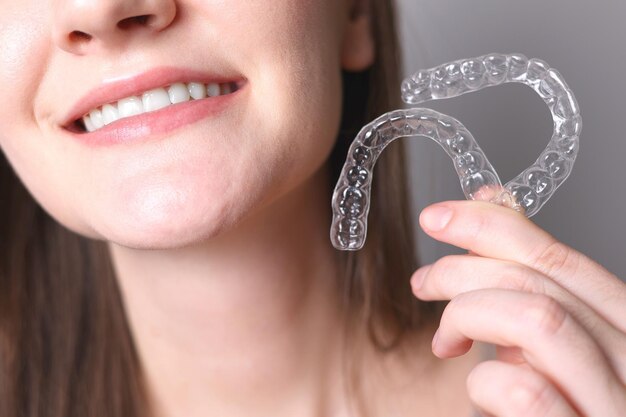
Invisalign has transformed the way we approach orthodontic treatment, offering a more discreet and comfortable alternative to traditional metal braces. However, understanding when Invisalign is deemed medically necessary requires a comprehensive examination of various clinical and health-related criteria. This article delves into the key factors that can make Invisalign a medical necessity, exploring the conditions that justify its use, and the impact of this treatment on overall dental health.
Understanding Invisalign: A Brief Overview
Invisalign is a revolutionary orthodontic treatment that utilizes a series of clear, removable aligners to straighten teeth. Unlike traditional braces, which use brackets and wires, Invisalign aligners are custom-made from smooth plastic, providing a more aesthetic and comfortable experience. The aligners are designed to gradually shift teeth into their correct positions over time.
When is Invisalign Considered Medically Necessary?
Determining whether Invisalign is medically necessary involves evaluating several factors, including the severity of dental issues, the impact on oral health, and the potential benefits of treatment. Here are key considerations:
1. Severe Malocclusion
Malocclusion refers to the misalignment of teeth and the way they fit together. Severe malocclusion can lead to various complications, including difficulty in chewing, speaking, and maintaining oral hygiene. In cases where traditional braces are not feasible or appropriate, Invisalign may be recommended as a medically necessary treatment option with SW Calgary dentist.
Types of Malocclusion Addressed by Invisalign:
- Class I Malocclusion: Normal bite but with misaligned teeth.
- Class II Malocclusion: Overbite where the upper teeth significantly overlap the lower teeth.
- Class III Malocclusion: Underbite where the lower teeth protrude beyond the upper teeth.
2. Impact on Oral Health
When dental misalignments are severe enough to cause gum disease, tooth decay, or jaw pain, Invisalign can become a medically necessary intervention. Proper alignment of teeth can improve oral hygiene, reduce the risk of periodontal issues, and alleviate discomfort associated with misaligned teeth.
Conditions Improved by Invisalign:
- Gum Disease: Misaligned teeth can make it challenging to clean thoroughly, increasing the risk of gum infections.
- Tooth Decay: Overlapping teeth can create hard-to-reach areas, fostering plaque buildup and leading to cavities.
- Jaw Pain and TMJ Disorders: Misalignment can contribute to temporomandibular joint disorders, causing pain and dysfunction.
3. Functional Impairments
Invisalign may be deemed medically necessary if dental misalignments significantly impair normal functions such as chewing, biting, and speaking. For instance, if an individual experiences difficulty in biting or chronic discomfort due to teeth positioning, Invisalign in SW Calgary can offer a functional solution that improves quality of life.
Functional Issues Addressed by Invisalign:
- Difficulty Chewing: Misaligned teeth can hinder effective chewing, leading to digestive problems.
- Speech Impediments: Certain misalignments can affect pronunciation and clarity of speech.
Evaluation Criteria for Medically Necessary Invisalign Treatment
For Invisalign to be considered a medical necessity, it must meet specific clinical criteria. Dentists and orthodontists evaluate several factors to determine if Invisalign is the most suitable treatment.
1. Comprehensive Dental Examination
A thorough dental examination is essential to assess the severity of misalignment and its impact on oral health. This may include:
- Clinical Examination: Assessing the alignment and occlusion of teeth.
- X-Rays and Scans: To visualize the underlying dental structures and diagnose issues.
2. Documentation of Dental Issues
Proper documentation of the patient’s dental condition and the impact on their daily life is crucial. This includes:
- Detailed Records: Including photos, X-rays, and clinical notes.
- Patient History: Documenting any history of dental problems and their effects on overall health.
3. Treatment Plan and Alternatives
A detailed treatment plan should be developed, outlining the expected outcomes and comparing Invisalign with other orthodontic options. This plan helps in justifying the necessity of Invisalign based on its benefits over traditional methods.
Insurance and Coverage for Medically Necessary Invisalign
Insurance coverage for Invisalign as a medically necessary treatment can vary based on the provider and the specific circumstances. Patients should:
- Consult with Their Insurance Provider: To understand coverage options and any requirements for documentation.
- Check for Pre-Approval: Some insurance plans may require pre-approval for Invisalign treatment.
The Benefits of Medically Necessary Invisalign
When deemed medically necessary, Invisalign can offer numerous benefits beyond mere aesthetics. These include:
- Improved Oral Health: Enhanced ability to maintain oral hygiene and prevent dental issues.
- Enhanced Comfort: Smooth aligners reduce irritation compared to traditional braces.
- Aesthetic Appeal: Clear aligners are less noticeable than metal braces.
Conclusion
Invisalign can be a medically necessary treatment for severe dental misalignments that impact oral health and daily functioning. By addressing conditions such as malocclusion, functional impairments, and oral health issues, Invisalign provides a comprehensive solution that improves both aesthetic and functional outcomes. Consulting with a qualified dentist in SW Calgary and exploring all available options is essential in determining the best course of treatment.